Due to Guatemala’s incredibly rich biodiversity, there are many species that, even when they are not national symbols, have become symbols in the identity of Guatemalans. In fact, many people born in this country grew up surrounded by these organisms since they have been deeply ingrained in the local traditions. While you learn about them in this article, and as the independence festivities come by, FLAAR, and FLAAR Mesoamérica extend a call to preserve not only these species, but also the rich ecosystems they live in, as well as all the other living things that inhabit the region.
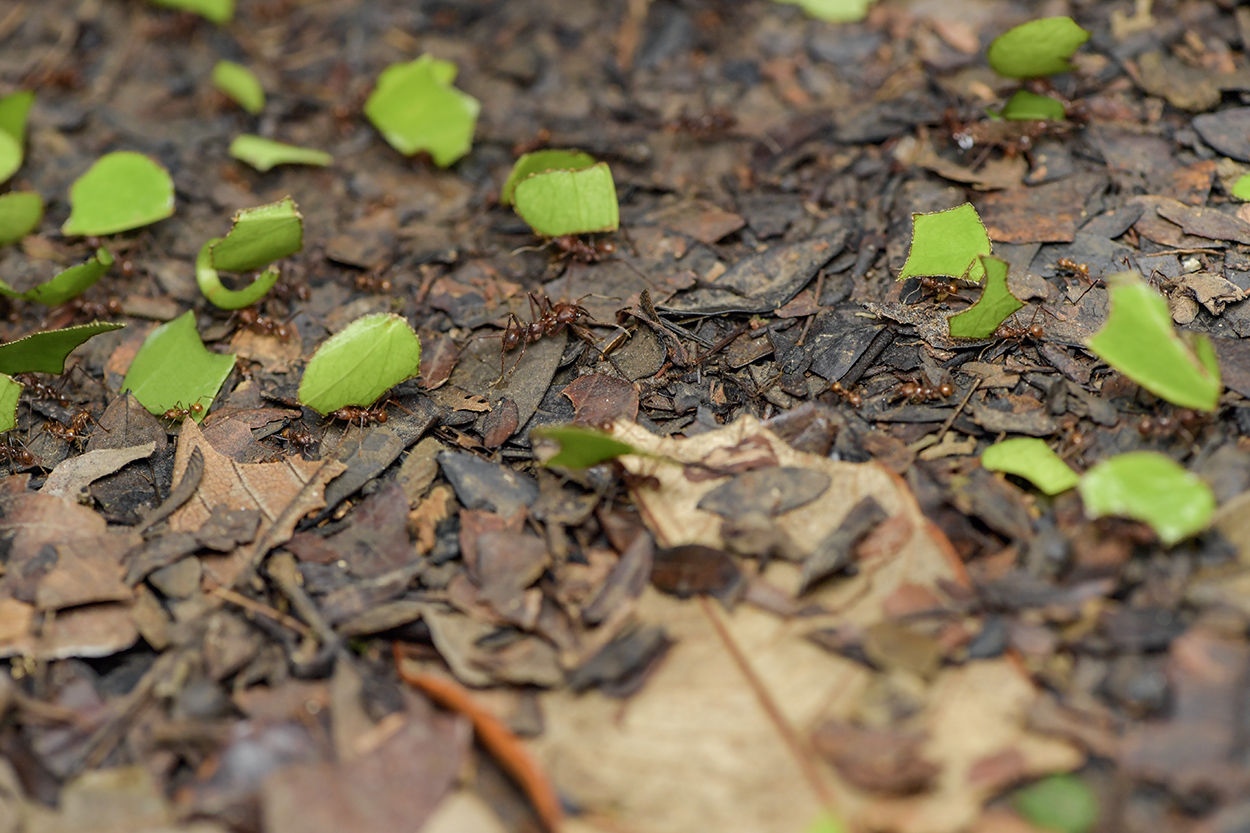
Although they don’t look exactly like the so-called “zompopos de mayo”, the leaf-cutter ants in this picture belong to the worker caste of the same species, Atta cephalotes. Tapón Creek, Livingston; March 12, 2020. Photo by David Arrivillaga.
Zompopos de mayo (Atta cephalotes)
The well-known zompopo de mayo in Guatemala is an ant species belonging to the leafcutter and fungi-cultivating genus Atta. These ants are often seen forming rows, and carrying leaf trimmings, which is a behavior typical of this group (Sáenz, 2022). They also build large nests in the form of hills, which if you live in Guatemala, you may have encountered at least once.
Their colonies are composed of different castes, which include among others, worker ants and the winged fertile caste. The former is in charge of various tasks, such as collecting leaf trimmings, cultivating the fungi that the colony feeds on, and taking care of the colony’s young (Sáenz, 2022). The latter participates in the nuptial flight, which coincides with the first heavy rains of each year.
Although these ants are active throughout the year, their activity notably increases with the onset of the rains (Saenz, 2022). And this is not a surprise since the fungi they feed on requires, as any other fungus, a humid environment to thrive and reproduce.

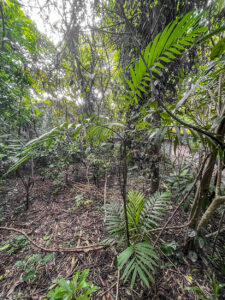
The pacaya palm, Chamaedorea tepejilote, is both used for its edible inflorescences, and as an ornamental palm. Photo at the left: inflorescence of C. tepejilote. FLAAR studio; January 23, 2016. Photo by Dr. Nicholas Hellmuth. Photo at the right: FLAAR ethnobotanical garden, August 24, 2024. Photo by Sergio D. Jerez.
Pacaya and xate palms (Chamaedorea spp.)
The different Chamaedorea species, commonly known as pacaya palms, or xates, are thin-stemmed, dioicus plants that are distributed throughout México and Central América (MacVean, 2017). They belong to the Arecaceae family, and are among the palm species that can only be found in the Americas. The fact that they are dioicus means that they have distinct male and female flowers, which are found on separate individuals.
Culturally, they hold an important place in Guatemalan traditions. The leaves of different species including C. elegans and C. tepejilote are used as decorations for family gatherings and Christian festivities, such as Christmas and The Eucharist. Moreover, their inflorescences are edible, and are highly esteemed in Guatemala.
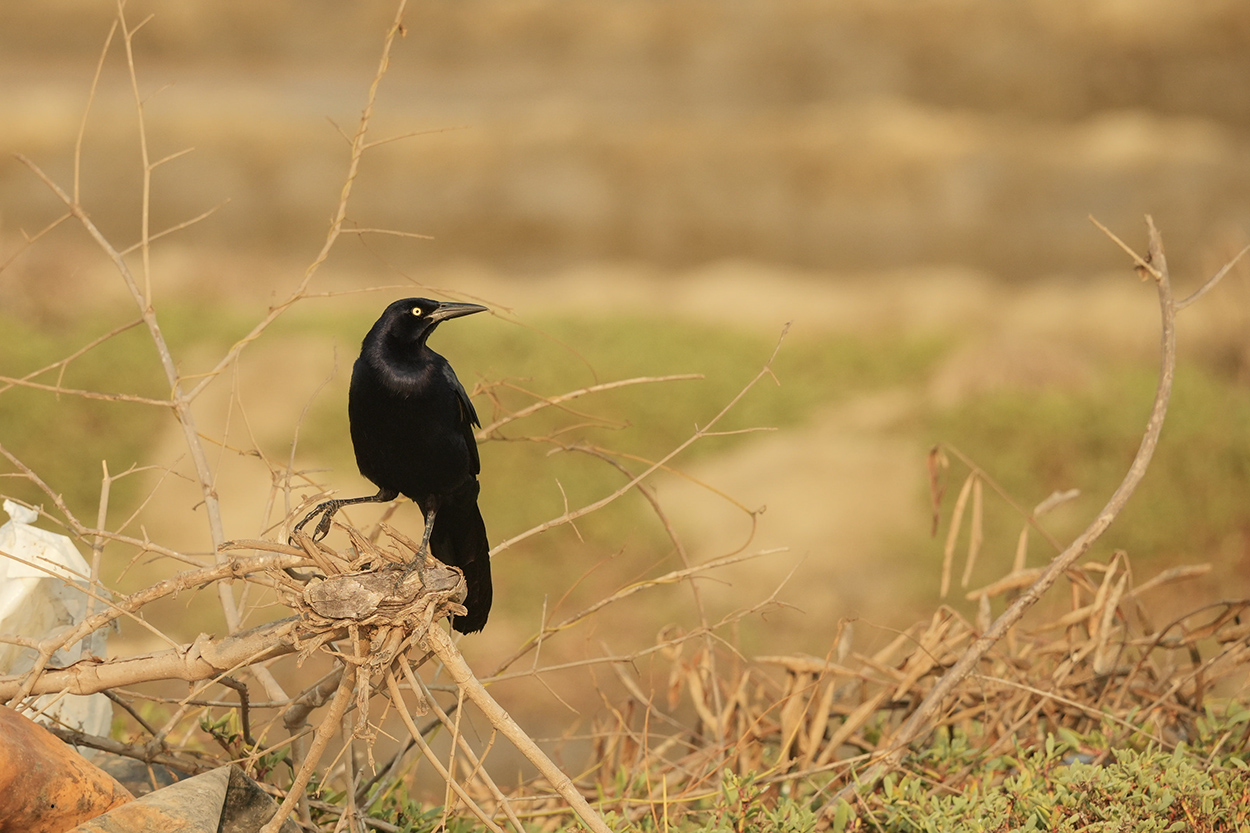
The clarinero male has darker and shinier plumage. Delicias del Mar Salt Farm, Monterrico; January 2024. Photo by Edwin Solares.
The Zanate or Clarinero (Quiscalus mexicanus)
The bird Quiscalus mexicanus, commonly known as “zanate” (the females) and “clarinero” (the males), is found throughout Central and North America. It belongs to the songbird family Icteridae, and is recognized for its adaptability to various environments, which makes it a generalist species. Its ability to thrive in both rural and urban areas is largely due to its high level of intelligence, as it is also to its ability to effectively utilize anthropogenic resources.
Quiscalus mexicanus is primarily diurnal, returning to its nest in the evenings, either alone or in groups, which can become rather massive. Its diet is highly varied and omnivorous, encompassing seeds, fruits, small invertebrates, meat, and human food. The birds can lay up to five eggs, which the female incubates for approximately 10 to 14 days. Both parents participate in feeding the chicks once they hatch.
The reason why these birds might be engraved in the lives of many Guatemalan people is not only due to the fact that they are one of the most common birds found in cities, villages, and rural settlements, but also because their loud calls can make quite an impression when they gather in hundreds.
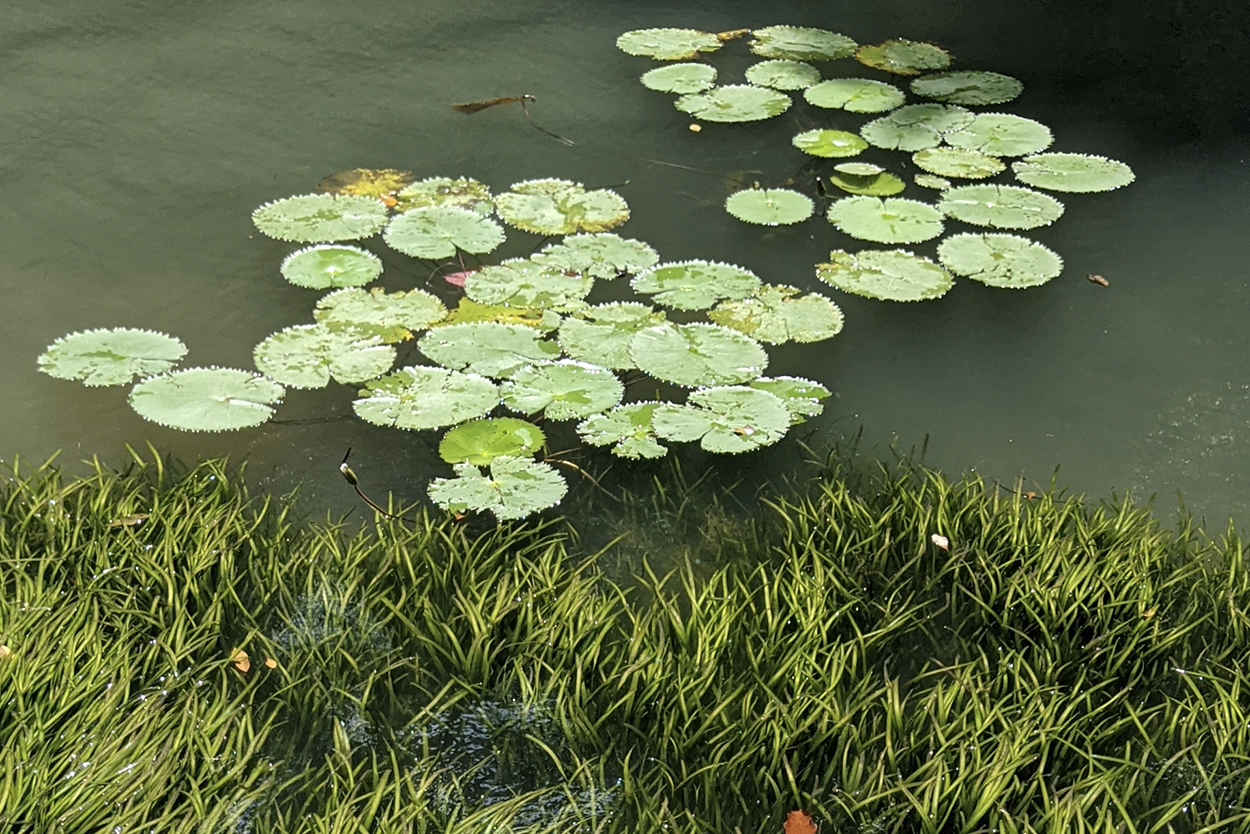
Eelgrass, Vallisneria americana, is among the plants that manatees may occasionally feed on. Livingston; September 4, 2021. Photo by Roxana Leal.
The Antillean Manatee (Trichechus manatus)
The Antillean Manatee (Trichechus manatus) is quite the icon of the Caribbean water systems of Guatemala. Also known as sea cows, they are aquatic herbivorous mammals that can be found, more specifically, across Lake Izabal, Río Dulce, and Amatique Bay.
Being herbivorous, Manatees graze along the seabed, feeding primarily on seagrass. This is why they are nicknamed “sea cows.” In addition, this feeding behavior is crucial, as it helps maintain balance in both marine and freshwater ecosystems.
In Mayan culture, the manatee was referred to as chiilbek or “big fish”. They were also attributed the symbolic meaning of representing motherhood, since during the breeding season, female manatees are dedicated to caring for their young (Alonso, 2000).
Despite their uniqueness, and symbolic significance, manatees currently face several threats. Boat traffic, climate change, and pollution pose significant risks to their habitats. As a result, these slow-moving marine mammals are now listed as “vulnerable” on the IUCN Red List.

Close-up of chipilín flowers. FLAAR Photo Archive.
Chipilín (Crotalaria longirostrata)
Chipilin is what the native herb Crotalaria longirostrata is called, which lives up to 2 years, and grows primarily in the Altiplano region of Guatemala. Its leaves have medicinal properties that induce sleep. Also, the leaves are one ingredient very unique to Guatemalan gastronomy.
An interesting fact of the chipilin plants is that they fold their leaves at night. This is an adaptation that some species have developed to avoid water-loss and herbivory predation (Gardens by the Bay, 2020).
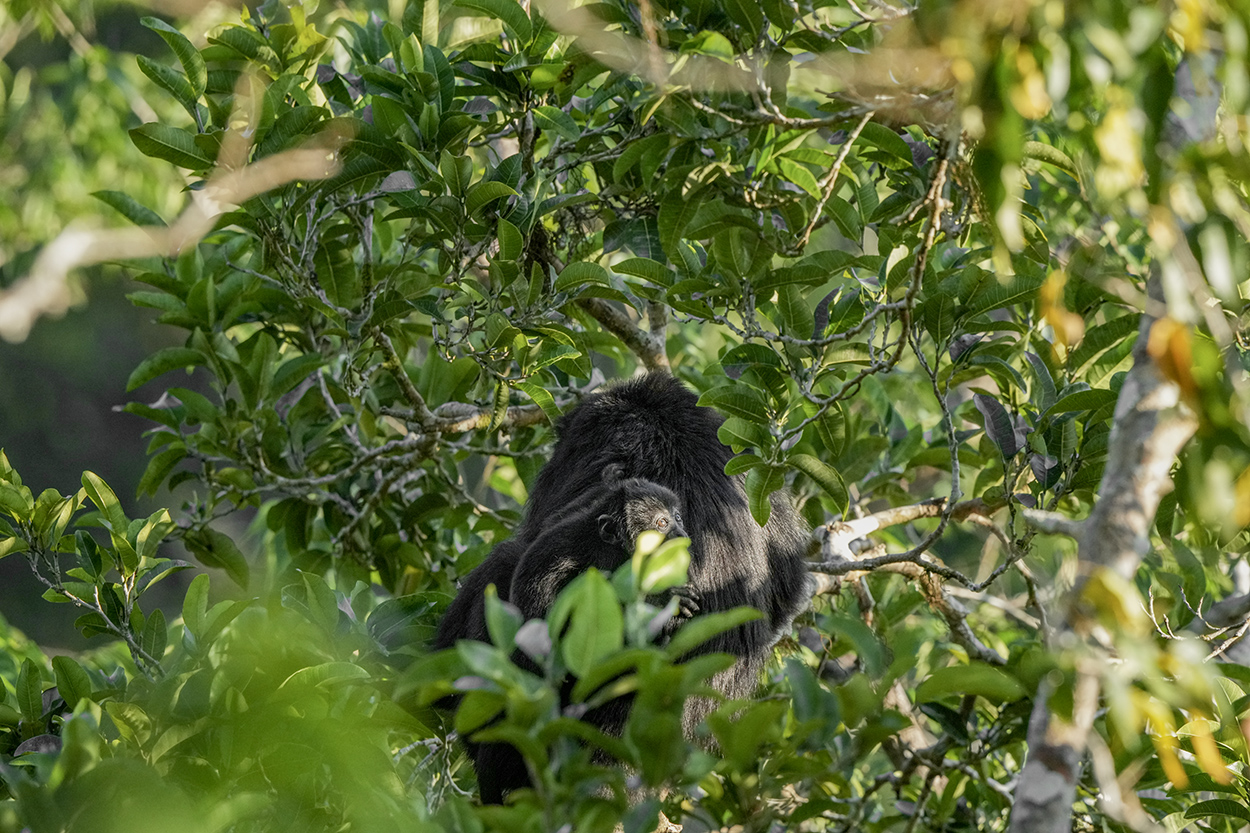
A baby black howler monkey. Tikal National Park, Petén; March 29, 2023. Photo by Edwin Solares.
Howler Monkeys (Alouatta pigra and Alouatta palliata)
There are two howler monkey species that can be found in Guatemala, Alouatta pigra and Alouatta palliata. The former, also known as Black Howler Monkey, is rather common in the rainforests of Alta Verapaz and Petén, and is hard to miss anytime its loud roar travels kilometers through the jungle. In fact, that is why it figures in this list of species. Its call is quite unforgettable, and may be deeply engraved in the memory of many people that have visited the jungles in the North of the country.
On the other hand, the species A. palliata, also known as Mantled Howler Monkey is unfortunately way less common, since its populations are currently endangered, and can be only found in some areas of Izabal. This monkey is distinguished by its dense, dark fur, with a golden stripe along its back. It has a robust body, long limbs, and a notably strong prehensile tail. These physical traits make the Mantled Howler Monkey an excellent climber, allowing it to move effortlessly among tree branches, as it is primarily arboreal. They also live in social groups that typically range from 10 to 20 individuals, and have a hierarchical organization based on age, and gender.
The main threats to the survival of the Mantled Howler Monkey are its habitat fragmentation, and habitat destruction, both caused by anthropogenic activities such as deforestation, agricultural expansion, and illegal hunting. These factors not only reduce the available living space for the monkeys, but also disrupt migratory routes, and seed dispersal, negatively impacting the entire ecosystems.

“Pez blanco” (Petenia splendida)
This is a fish species that can only be found in the North of Guatemala. In fact, it is endemic to Lake Petén Itzá, although it has presumably been introduced in other waterbodies (Gutiérrez, 2022).
The fish could be considered a culturally significant species due to the fact that it has been appropriated as one of the most important ingredients in all the villages that surround Lake Petén Itzá.
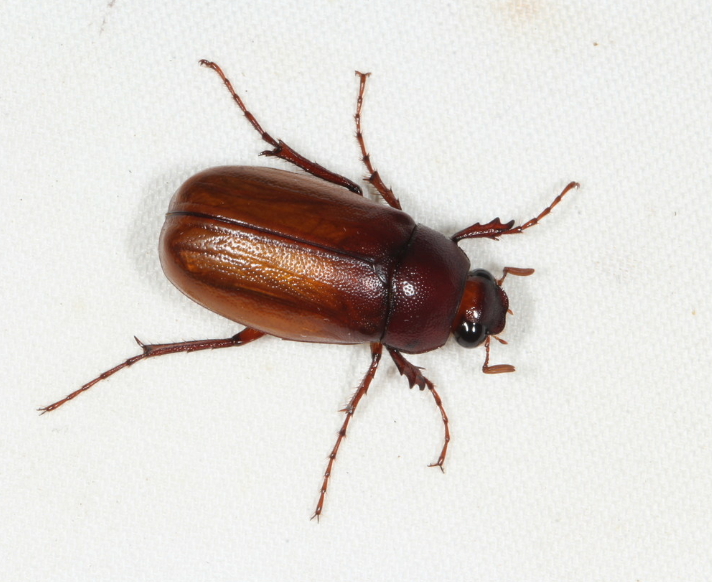
Photo by Rolando Ramírez, retrieved from https://www.gbif.org/species/4992955. Used under the ATTRIBUTION-NONCOMMERCIAL 4.0 INTERNATIONAL (https://creativecommons.org/licenses/by-nc/4.0/).
The “Ronrón” beetle
“Ronrón”, and “ronrones” (in plural) are the common names in Guatemala for a group of beetles in the Scarabaeidae family, which belong to the genus Phyllophaga. However, these insects are actually widespread across the Americas. They are particularly common in humid or temperate climates, and are primarily nocturnal. Ronrones (ronrón beetles) are known for their distinctive behavior of being attracted to strong light sources at night. In Guatemala, their popularity comes from their amusing habit of constantly bumping into walls, or other surfaces while flying in the search for light. This behavior is attributed to their poorly developed sense of sight.
As nocturnal insects, ronrones are active and feed during the night. During the day, they hide under leaf litter, in the soil, or in dense vegetation to avoid predators and extreme environmental conditions, such as high temperatures. They are generalists, inhabiting a variety of environments from woodland areas to agricultural fields. They also usually inhabit areas with loose, well-drained soils where females can easily lay their eggs and larvae can move freely.
Ecologically, the role of the ronrones is dual. On one hand, they can become significant predators due to their potential to reproduce, and feed on plant matter. On the other hand, in natural ecosystems, they contribute to the nutrient cycle by breaking down organic matter in the soil during their larval stage, and serve as an important food source for various predators, including birds, insectivorous mammals, and other insects.
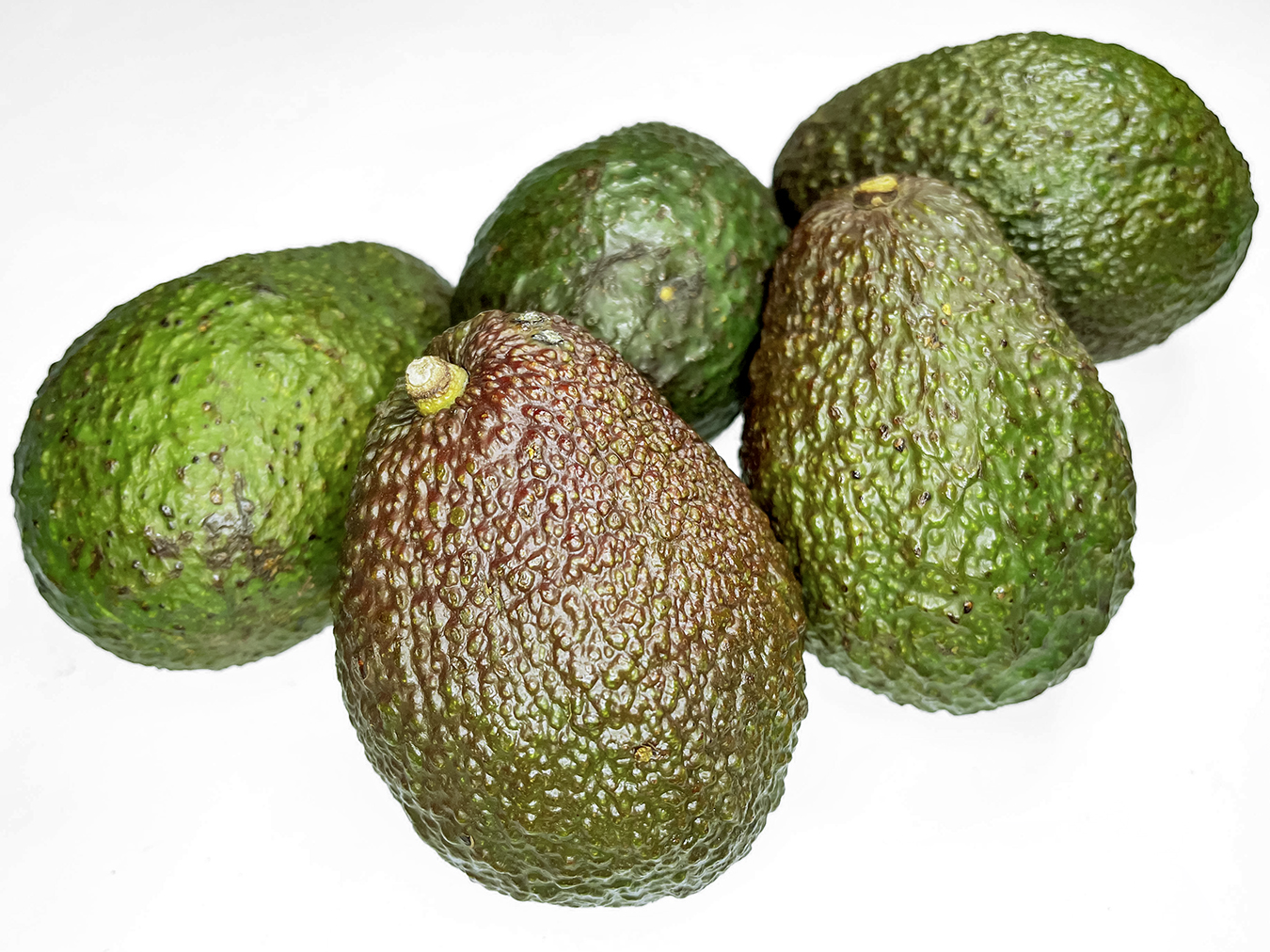
Avocados are available all year long in Guatemalan markets, where they are part of the everyday diet. FLAAR studio; August 24, 2024. Photo by Sergio D. Jerez.
The Avocado
The avocado, from the genus Persea, is a tree native to the Mesoamerican region, particularly from different areas in Mexico and northern Guatemala. It belongs to the Lauraceae family. In Guatemala, there are two main species: Persea americana, mainly known as a commercial crop, and Persea schiedeana, known as a “wild” avocado. In Mesoamerica and other parts of Central America, the fruit is referred to as “aguacate,” while in South America, it is called “palta”.
In Mayan and Aztec cultures, avocados were considered sacred and a gift from the gods. Its shape was associated with fertility, attributing mystical values to it. It was also a staple food in these cultures, consumed either alone, or with other crops such as corn, beans, and chili. Additionally, infusions made from avocado leaves and fruit were used to treat various ailments, such as stomach aches and menstrual cramps.
The avocado’s nutritional benefits have continued to be appreciated over time. Today, it remains one of the most sought-after foods globally. Its rich nutritional profile, including high vitamin and macronutrient content, along with its flavor and texture, makes it a popular ingredient in culinary dishes around the world. Furthermore, its unique properties have led to its incorporation in various skincare products, vitamin capsules, medications, and even dental care products.
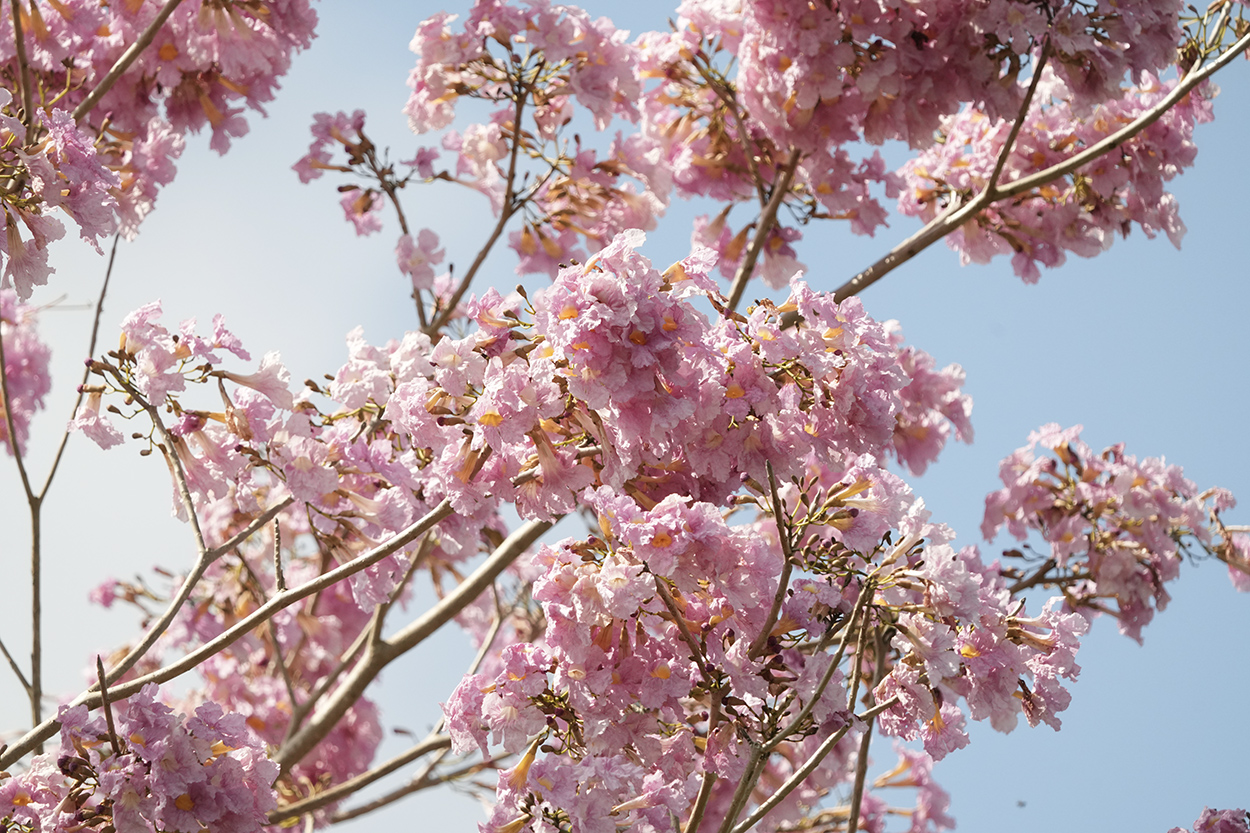
Matilisguate trees are not only beautiful, but also rather common in the Maya Lowlands. Río Escondido, Petén; 2023. Photo by David Arrivillaga.
The matilisguate tree (Tabebuia rosea)
The beautiful matilisguate is a tree species that can be found in the lowlands of Guatemala. Its most memorable characteristic is the abundance of pink, pale-pink, or white flowers it sets in Spring. In this regard, many Guatemalans may recall the beautiful matilisguate trees that grow in Guatemala City, when they adorn the streets with its flowers, or perhaps, the matilisguate trees that grow in the wild. For instance, they are common alongside some of the highways in the Pacific Coast, and in Petén.
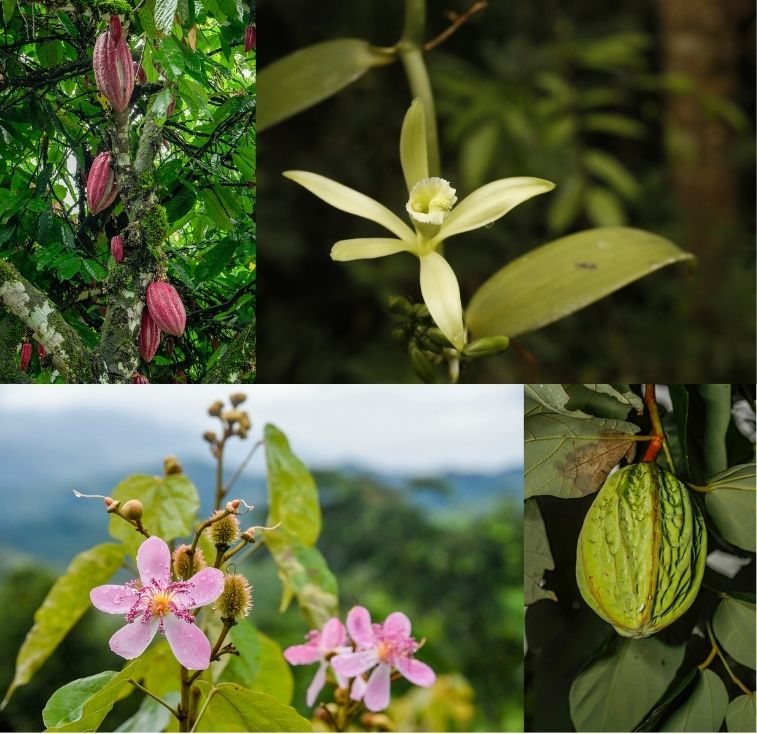
From top to bottom, clockwise: cacao pods hanging from a tree; Vanilla sp. flower; flowers of Bixa orellana, and a fruit of pataxte (Theobroma bicolor), a substitute for cacao. FLAAR Photo Archive.
The cacao blend: cacao, vanilla, and other flavorings
The use of several native plants, which are linked to the consumption of cacao is part of the local knowledge that has been passed down through generations in Guatemala. In addition, some of these species such as cacao itself, and vanilla, have become widespread worldwide. Take a closer look at a few of these species, which surely may be part of the Guatemalan identity too.
Cacao (Theobroma cacao) is a species that has achieved global popularity. While it is primarily known as the central ingredient in chocolate, and its derivatives, cacao had different preparation methods, and significance in Mesoamerican cultures. In Maya, and Aztec civilizations, cacao beans were fermented, dried, roasted, and ground to create a frothy drink, to which flavorings such as nuts, vanilla, or chili were added. Many communities considered cacao a sacred food, associated with the gods, and consumed it during religious and cultural ceremonies. Depending on the spices added, the drink could have aphrodisiac, energizing, or even hallucinogenic effects. Nowadays, it is still an important part of the culture of different local communities.
As it was introduced in the paragraph above, the consumption of vanilla is also deeply engraved in the roots of Guatemalan culture. This is not surprising, since there are at least two vanilla orchids, V. insignis and V. planifolia, that grow wild in the country. However, their wild populations are at risk of becoming endangered, primarily due to habitat destruction.
Finally, the species Bixa orellana, also known as annatto or “achiote”, is a native plant used both as a flavoring, and as a natural dye. For instance, it is used in various dishes, such as the traditional Q’eqchi’ dish called kak’ik, to give them a distinctive reddish color. The main component of the colorant extracted from annatto is bixina, a natural antioxidant with medicinal properties.
Pumpkins and pumpkin relatives
In Guatemala, there is a wide diversity of cucurbitaceous species that are integral to the daily diet and, consequently, to the country’s culture. The Cucurbitaceae family, a group of flowering plants, includes nearly a thousand species worldwide, with more than twenty of these cultivated in Guatemala. Among these, some of the most popular are “güicoy” (Cucurbita pepo), “ayote” (Cucurbita moschata), “chilacayote” (Cucurbita ficifolia), and “pepitoria” (Cucurbita argyrosperma).
Some of the most common, and traditional ways in which some of these species are used by Guatemalans include the preparation of the dish ayote en dulce, and the addition of pepitoria to various foods. Ayote en dulce is a traditional conserve, made by stewing the ayote with cinnamon, panela sugar, and other spices. It is primarily consumed during some end-of-year festivities, including All Saints’ Day. Pepitoria, on the other hand, is used both as a soup thickener, and as a type of condiment that Guatemalans enjoy with various fruits.
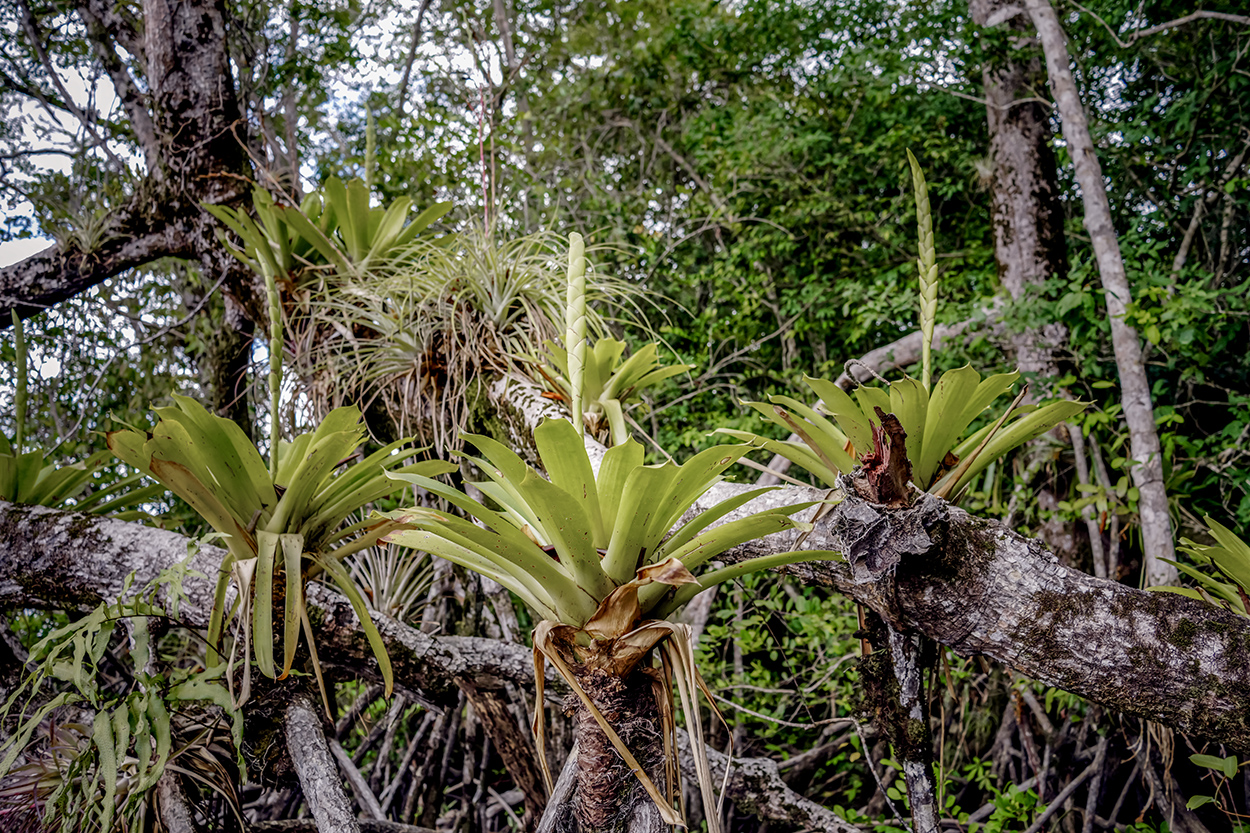
The beautiful Werauhia gladioliflora is a bromeliad that can be found growing in the roots of mangrove trees. Livingston, Izabal. FLAAR Photo Archive.
Epiphytes: bromeliads, orchids, and many more (even cactus!)
The term epiphytes refers to plants that grow on other plants, usually on trees, without parasitizing them, and with no contact with soil. In Guatemala, they abound, turning the local ecosystems into quite astonishing, and unforgettable landscapes. Such diversity of epiphytes includes plants from different plant families, among which, some have made their way into local traditions.
“Gallitos” are an example of a common epiphytic plant found in Guatemala. Such a name encompasses different bromeliad species in the genus Tillandsia. These can be found not only on trees but also on electrical cables, light posts, and other tall objects throughout the country, and a few are used as decorations in some of the local festivities.
Orchids are another group of plants that can be found abundantly in Guatemala. They are not only valued for their diversity, and beauty, but also hold cultural value in the national identity. For instance, the species Lycaste virginalis is currently the national flower, which represents the country’s pride, and its unique biodiversity.

A Horned Guan individual, standing on a branch of an aguacatillo tree (Ocotea sp.). Volcán Tolimán, Sololá; march 8, 2021. FLAAR Photo Archive.
The Horned Guan
The Horned Guan (Oreophasis derbianus), which is a species endemic to Guatemala and southeastern Chiapas, is the last species on this list. It is currently categorized as “Endangered” on the IUCN Red List of Threatened Species, due to the significant threats it faces, including hunting, illegal trade, and habitat destruction.
The horned guan is among the species that define the identity of Guatemalans, not only due to its reduced distribution in the world (which encompasses the country), but also because of its beauty, uniqueness, and curious behavior. The bird has a red-orange horn on its head, a distinctive eye pattern, blue-black feathers on its back, and is relatively large in size, with an approximate length of 80 cm.
Moreover, its behavior is rather elusive, which is why both Guatemalans and tourists from all over the world travel to the few locations of Guatemala where it can be seen. Such an event is rare, and therefore valued.
AGRICULTURA and SENASICA
2023 Phyllophaga spp., Macrodactylus spp., Anomala spp. Complejo Gallina Ciega.
Ficha Técnica. Dirección General de Sanidad Vegetal Dirección del Centro Nacional de Referencia Fitosanitaria del Gobierno de México. Available in PDF: chrome-extension://efaidnbmnnnibpcajpcglclefindmkaj/https://www.gob.mx/cms/uploads/attachment/file/847747/Ficha_t_cnica_Complejo_gallina_ciega.pdf
ALDANA-ESTRADA, A.J.
1999 Evaluación del rendimiento y calidad de la fruta para exportación de 10 híbridos de
melón tipo “cantaloupe” (Cucumis melo L. var. reticulatus), bajo las condiciones del valle de La Fragua, Zacapa. [Tesis en el grado de académico licenciado]. Universidad San Carlos de Guatemala.
ALONSO, E.
2000 El Manatí. Instituto Latinoamericano de la Comunicación Educativa.
http://bibliotecadigital.ilce.edu.mx/Colecciones/index.php?clave=manati&pag=3
ARROYO, V., and MANDUJANO, S.
2006 Forest fragmentation modifies habitat quality for Alouatta palliata. International
Journal of Primatology, 27, 1079-1096.
AUDUBON.ORG
2024 Zanate Mayor (Quiscalus mexicanus) Sociedad Nacional Audubon.
https://www.audubon.org/es/guia-de-aves/ave/zanate-mayor
BARRIENTOS, A., BARRIENDOS, P. and LÓPEZ, L.
2001 HISTORIA Y GENÉTICA DEL AGUACATE.
http://209.143.153.251/Journals/CICTAMEX/CICTAMEX_1998-2001/CICTAMEX_1998-2001_PG_100-121.pdf
BROKAW ESPAÑA
2024 Variedades de aguacate.
https://www.viverosbrokaw.com/productos/aguacate/variedades-de-aguacate/De la Vega-Rivera, A., & Merino-Pérez, L. (2021). Socio-environmental impacts of the avocado boom in the Meseta Purépecha, Michoacán, México. Sustainability, 13(13), 7247
BUENO, I.
2024 El cacao, la bebida sagrada de Mayas y Aztecas. Historia – National Geographic.
https://historia.nationalgeographic.com.es/a/cacao-bebida-sagrada-mayas-aztecas_18447
CENTINO, R.
2022 Receta de Kak’ik guatemalteco. Cocina y Cultura Guatemalteca – Guatemala.com.
https://aprende.guatemala.com/cultura-guatemalteca/cocina/receta-de-kakik-guatemalteco/
CENTINO, R.
2023 Origen y usos de la pepitoria, importante ingrediente en la gastronomía de
Guatemala. Cocina y Cultura Guatemalteca – Guatemala.com. https://aprende.guatemala.com/cultura-guatemalteca/cocina/origen-y-usos-de-la-pepitoria-importante-ingrediente-en-la-gastronomia-de-guatemala/
CHARLAT, S., THATCHER, O. R., HARTMANN, N., PATEL, Y. G., SAILLAN, M. and VOOREN, E.
2000 Survey of Alouatta palliata at the Bilsa Biological Reserve, north-west Ecuador.
Neotropical Primates, 8(1), 40-44.
COUTIÑO-CORTÉS, A.G., BERTOLINI, V., ARCHILA, F. y VALLE-MORA, J.F.
2018 El uso ornamental de Guarianthe skinneri (Orchidaceae), en Chiapas y Guatemala,
determina parcialmente su diversidad y estructura genética. https://www.researchgate.net/publication/325461376_El_uso_ornamental_de_Guarianthe_skinneri_Orchidaceae_en_Chiapas_y_Guatemala_determina_parcialmente_su_diversidad_y_estructura_genetica
DUARTE, P., CHAVES, M., BORGES, C. and MENDONCA, C.
2016 Avocado: characteristics, health benefits and uses. Ciência rural, 46(4), 747-754.
EBIRD (CORNELL LAB OF ORNITHOLOGY)
2024 Great-tailed Grackle (Quiscalus mexicanus).
https://ebird.org/species/grtgra?siteLanguage=es
FLORES, M., SARAVIA, C., VERGADA, C., AVILA, F., VALDÉS, H. and ORTIZ, J.
2019 Avocado oil: Characteristics, properties, and applications. Molecules, 24(11), 2172.
GARDENS BY THE BAY
2020 Plants can “wake and sleep”.
https://www.gardensbythebay.com.sg/en/learn-with-us/explore-resources/articles/plants-can-move.html#:~:text=As%20the%20sun%20sets%2C%20they,midnight%20snack%20for%20hungry%20herbivores.
GOBIERNO DE MÉXICO
2024 El aguacate ayuda a tu salud y a prevenir padecimientos.
https://www.gob.mx/salud/articulos/conoce-los-beneficios-del-aguacate#:~:text=Sab%C3%ADas%20que%20es%20un%20fruto%20que%20se%20cultiva%20todo%20el%20a%C3%B1o.&text=Contiene%20alrededor%20de%2015%20nutrientes,Sodio%2C%20as%C3%AD%20como%20grasa%20monoinsaturada.
GONZÁLES-GARCÍA, F.
2012 El Pavón (Oreophasis derbianus), una especie cuasiendémica a México. Instituto
de Ecología, Universidad de Alicante. El canto del Cenzontle 3 (1): 1-25. https://www.researchgate.net/publication/265466663_El_pavon_Oreophasis_derbianus_una_especie_cuasiendemica_a_Mexico
GUTIERREZ, F.
2022 Petenia splendida (Günther, 1862). Cíclidos México.
https://www.ciclidos-mexico.com/InformativoCM/2022/06/09/petenia-splendida-gunther-1862/
HAEMIG, P. D.
2012 Introduction of the Great-Tailed Grackle (Quiscalus mexicanus) by Aztec Emperor
Auitzotl: provenance of the historical account. The Auk, 129(1), 70-75.
HELLMUTH, N.
2022 El florecimiento de la orquídea de vainilla silvestre documentado en bosques bajos
estacionalmente inundables. FLAAR Mesoamérica. https://flaar-mesoamerica.org/wp-content/uploads/2023/08/Yaxha-to-Nakum-PLUS-RBM-Vanilla-insignis-May-2022-NH-JG-traduccion-espanol.pdf
HELLMUTH, N.
2023 Orquídea de vainilla silvestre Vanilla insignis. FLAAR Mesoamérica.
https://flaar-mesoamerica.org/wp-content/uploads/2023/08/Yaxha-to-Nakum-PLUS-RBM-Vanilla-insignis-May-2022-NH-JG-traduccion-espanol.pdf
HIDALGO, E.
2001 Uso de microorganismos para el control de Phyllophaga spp. Manejo Integrado de
Plagas (Costa Rica). ) No. 60.
IUCN.
2024 Horned Guan – Oreophasis derbianus.
https://www.iucnredlist.org/species/22678453/177970135
MACVEAN, A.
2017 Chamaedorea sp. https://arboretum.ufm.edu/plantas/chamaedorea-sp/
MANDUJANO, S., ESCOBEDO, L., and PALACIOS, R.
2004 Movements of Alouatta palliata among forest fragments in Los Tuxtlas, México.
Neotropical Primates, 12(3), 126-131.
MARTÍNEZ, F.M.
2015 El achiote, saborizante precolombino. Prensa Libre.
https://www.prensalibre.com/uncategorized/saborizante-precolombino/
MARTINEZ. J., PEREZ, R., MENDOZA, L., and QUIRÓS, D. I.
2022 Ethogram of the common behavior of Quiscalus mexicanus (Passeriformes:
Icteridae) in the republic of Panama. Tecnociencia, 24(1), 72-86.
MEDIO AMBIENTE and CONAFOR
2013 Phyllophaga (spp): Ficha técnica e informativa.
https://sivicoff.cnf.gob.mx/ContenidoPublico/08%20Guías%20de%20síntomas%20y%20daños/Guías%20de%20síntomas%20y%20daños%20nativas/Phyllophaga_Version%20Larga.pdf
MENDOZA, V.
2023 Guía de Flora de las Fiestas de Corpus.
https://www.instagram.com/p/CtXwUAaOh_y/?igsh=MTdoeW1hdGM1cDY1OQ==
MORÓN, M.A.
2003 Las especies de Phyllophaga (s.str.) del grupo rugipennis (Coleoptera:
Melolonthidae). Sociedad Entomológica Aragonesa; Instituto de Ecología y Biología Ambiental (IEBA) Università degli Studi di Urbino Urbino, Italia. http://sea-entomologia.org/PDF/M3M_3_ESCARABAIDOS/019_034_Phyllophaga.pdf
OLOGUÍN, M. y ROJAS-GARCÍA, D.
2022 El cacao, de los mayas para el mundo. Revista Global de la Universidad Nacional
Autónoma de México. https://unamglobal.unam.mx/global_revista/cacao-de-los-mayas-para-el-mundo-2/#:~:text=Nuestros%20antepasados%20originarios%20de%20Mesoam%C3%A9rica,%C3%A9stas%20preparaban%20una%20bebida%20espumosa.
PEER, B. D., and SEALY, S. G.
2001 Mechanism of egg recognition in the great-tailed grackle (Quiscalus mexicanus).
Bird Behavior, 14(2), 71-73.
PROCER
2020 Mono Aullador de Manto (Alouatta palliata). COMISIÓN NACIONAL DE ÁREAS
NATURALES PROTEGIDAS DE MÉXICO. https://simec.conanp.gob.mx/Publicaciones2020/Publicaciones%20CONANP/Parte%202/Monitoreo/2016%20Ficha%20Mono%20aullador%20de%20manto.pdf
RAMÍREZ, M.
2023 El cacao, un cultuvo milenario que en México tiene una tendencia a desaparecer.
Sistema de Noticias de la Universidad Veracruzana. https://www.uv.mx/cienciauv/blog/cacaodesaparecer/#:~:text=Nuestros%20antepasados%20utilizaban%20el%20cacao,plantaciones%20cuidadas%20por%20el%20hombre
REID, A.F.
2009 A Field Guide to the Mammals of Central America and Southeast Mexico. Oxford
University Press.
REYES-DÍAZ, K.
2019 Las epífitas son plantas, no parásitos: Thorsten Krömer. Sistema de Noticias de la
Universidad Veracruzana. https://www.uv.mx/prensa/banner/las-epifitas-son-plantas-no-parasitos-thorsten-kromer/#:~:text=Las%20ep%C3%ADfitas%20son%20plantas%20que,primeras%20s%C3%B3lo%20lo%20usan%20como
RUNESTAD, J., and GLANDER, K. E.
2020 Sexual dimorphism and growth in Alouatta palliata based on 20+ years of field
data. American journal of physical anthropology, 172(4), 545-566.
SCHAFFER, B., WOLSTENHOLME, B. and WHILEY, A.
2013 The avocado: botany, production and uses. CABI.
SHAPIRO, M.
2024 Los mejores alimentos del mundo maya.
https://www.nationalgeographic.es/viajes/los-mejores-alimentos-del-mundo-maya
SCHUSTER, J. and MONZÓN, J.
2018 Coleópteros de Guatemala, una guía para familias comunes. Editorial Universitaria
– UVG.
SÁENZ, L.
2022 ¿Qué son los llamados “zompopos de Mayo” en Guatemala?
https://flaar-mesoamerica.org/2022/05/31/what-are-the-so-called-in-guatemala-zompopos-de-mayo/
THE CORNELL LAB OF ORNITHOLOGY
2024 Great-tailed Grackle (Quiscalus mexicanus). The Cornell University Bird DataBase.
https://www.allaboutbirds.org/guide/Great-tailed_Grackle/overview
UNIVERSIDAD FRANCISCO MARROQUÍN (UFM)
s.f. Phyllophaga obsoleta. https://arboretum.ufm.edu/animales/phyllophaga-obsoleta/
UNIVERSIDAD FRANCISCO MARROQUÍN (UFM)
s.f. Phyllophaga tenuipilis.
https://arboretum.ufm.edu/animales/phyllophaga-tenuipilis/#:~=G%C3%A9nero%20de%20escarabajos%20de%20distribuci%C3%B3n,continentes%20de%20Am%C3%A9rica%20y%20Europa
VALLEJO, F., MORÓN, M. A. and ORDUZ, S.
2007 BIOLOGY OF Phyllophaga obsoleta BLANCHARD (COLEOPTERA:
MELOLONTHIDAE), A ROOTCHAFER SPECIES FROM THE WHITE GRUBS COMPLEX OF COLOMBIA. Boletín Científico. Centro de Museos. Museo de Historia Natural, 11(1), 188-204.
WEHNCKE, E. V., VALDEZ, C. N., and DOMÍNGUEZ, C. A.
2004 Seed dispersal and defecation patterns of Cebus capucinus and Alouatta palliata:
consequences for seed dispersal effectiveness. Journal of Tropical Ecology, 20(5), 535-543.
WEHTJE, W.
2003 The range expansion of the great‐tailed grackle (Quiscalus mexicanus Gmelin) in
North America since 1880. Journal of Biogeography, 30(10), 1593-1607.
World Flora Online.
2024 Lycaste virginalis (Scheidw.) Linden.
https://www.worldfloraonline.org/taxon/wfo-0000231318
World Flora Online.
2024 Theobroma cacao L. https://www.worldfloraonline.org/taxon/wfo-0000458440
World Flora Online.
2024 Bixa orellana L. https://www.worldfloraonline.org/taxon/wfo-0000342565
World Flora Online.
2024 Cucurbita moschata Duchesne.
https://www.worldfloraonline.org/taxon/wfo-0000342565
World Flora Online.
2024 Cucurbita pepo L. https://www.worldfloraonline.org/taxon/wfo-0000629123
Written by the FLAAR Mesoamérica Research Team (researchers Alejandra Valenzuela, Mariana Rivas, Sergio D. Jerez and Víctor Mendoza)
Edited by researcher Sergio D’angelo Jerez
